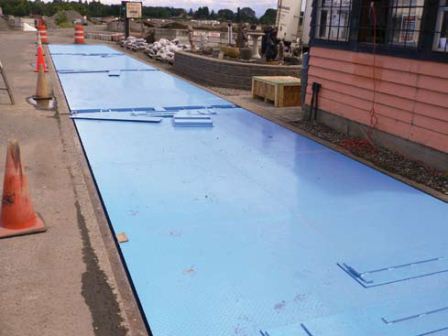Specially Modified Truck Scale/Weighbridge Is Perfect Solution
Scappoose Sand & Gravel – named for the city of Scappoose, Oregon, USA, where it is located, which is an old Indian name that means “gravelly plain” – supplies upwards of 650,000-700,000 tons of material annually to its customers. The finished products, which are utilized for applications such as manufacturing of concrete and asphalt for road construction, comprise the majority of most of the highways in the area.
To track the large quantities of sand and gravel that it distributes, Scappoose relies on a truck scale installed in a rectangular concrete pit. However, when electrical impulses from an extremely-close lightning storm short-circuited the electrical equipment in their already-worn scale, the company was unable to continue weighing products and was forced to estimate the quantities of material that were being shipped in trucks. Scappoose Sand & Gravel needed a replacement scale, and they needed it fast. The problem was, off-the-shelf scales didn’t fit in their existing pit and redoing the pit would prove costly – at double the expense of simply replacing the scale – and require additional time. The solution, as discovered by Scappoose owner, Scott Parker, was a specially designed truck scale from Avery Weigh-Tronix.
“Avery Weigh-Tronix offered the capability of modifying a scale to fit our requirements – and to do so very speedily,” Parker said. The truck scale, suggested by Mark Hudzinski, Regional Sales Manager at Avery Weigh-Tronix, delivers a robust weighing solution paired with a remote indicator that allows an operator to program in the lightweight of numerous vehicles. The scale provides the accurate net weight of a loaded truck, allowing Scappoose to simply gather, document and store product weight information.
Easy to operate
“The system is so easy to operate that everyone was able to learn it quickly,” Parker said. “Our employees can simply print out tickets that show the weight of materials in the truck, time of weighing and additional pertinent statistics as well as store this accumulated information on a daily basis.”
The new weighing system was installed in July 2007 and, as planned, required minimal modifications to the existing concrete structure.
“The scale was designed to sit significantly higher than the previous scale, requiring us to pour concrete bases on each of the legs on the new scale,” Parker said. “Although it wasn’t a major construction, everything had to be precise.”
“The drawings that we provided them from the factory to revamp some of the piers in the pit were dead on,” Hudzinski said. “All of the dimensions were correct. Everything went smoothly and quickly.”


 United Kingdom
United Kingdom  Canada
Canada  Canada (fr)
Canada (fr)  India
India  Malaysia
Malaysia  Ireland
Ireland